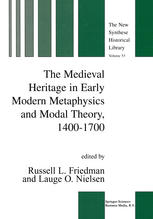

Most ebook files are in PDF format, so you can easily read them using various software such as Foxit Reader or directly on the Google Chrome browser.
Some ebook files are released by publishers in other formats such as .awz, .mobi, .epub, .fb2, etc. You may need to install specific software to read these formats on mobile/PC, such as Calibre.
Please read the tutorial at this link: https://ebookbell.com/faq
We offer FREE conversion to the popular formats you request; however, this may take some time. Therefore, right after payment, please email us, and we will try to provide the service as quickly as possible.
For some exceptional file formats or broken links (if any), please refrain from opening any disputes. Instead, email us first, and we will try to assist within a maximum of 6 hours.
EbookBell Team

4.0
96 reviewsOn the most basic level, the articles brought together in the present volume aim to contribute to the charting of the (often subtle) links between the medieval and early modern periods in the fields of metaphysics, philosophical theology, and modal theory. In selecting this line of inquiry the volume is consciously intended to offer support for the stance that in the higher or speculative sciences no sharp divide exists between the later Middle Ages, on the one hand, and the Renaissance and early modern period, on the other. In adopting such an approach, one emphasizing historical continuity instead of discontinuity, the volume can be seen as challenging at least two related sets of convictions concerning the intellectual life of the period 1400-1700. First, prominent Renaissance and early modem thinkers portrayed their own intellectual projects and accomplishments as radical breaks with the scholasticism characteristic of the Middle Ages and also dominant in their own time; the volume to no small extent takes as its point of departure a reluctance - or, at least, a hesitation - to accept these bold claims. Second, a large part of nineteenth- and twentieth-century historiography has taken the Renaissance and early modern claims of fundamental innovation at face-value; in emphasizing the continuity that exists between the thought of the medieval and of the early modern periods, the volume is part of an attempt to offer a more balanced view of the intellectual production of the later period.